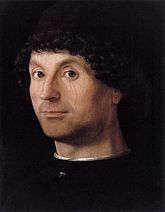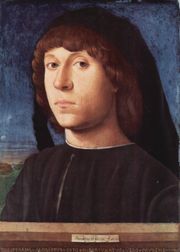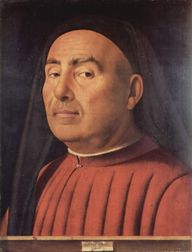- Male portraits by Antonello da Messina
-
Portrait of a Man is the conventional title of several male portraits finished by the Italian Renaissance artist Antonello da Messina in the course of his career. These include the famous portrait usually known as The condottiero, now in the Louvre of Paris.
Portrait of a Man 
Artist Antonello da Messina Year 1460s Type Tempera of wood Dimensions 27 cm × 20 cm (11 in × 7.9 in) Location Museo Civico Malaspina, Pavia Portrait of a Young Man 
Artist Antonello da Messina Year c. 1475 Type Mixed technique on wood Dimensions 27.5 cm × 21 cm (10.8 in × 8.3 in) Location Fundacion Thyssen-Bornemisza, Madrid Contents
Portrait of a Man (1460s - Pavia)
The picture, in the Town Museum of Pavia (Lombardy) is signed according to the Flemish habit, by directly engraving the painter's name on the parapet in the lower foreground (instead of using a false glued panel), like the Madrid portrait. Despite the sign, the strict nearness to the Flemish portrait art and the poor state of preservation have pushed some scholars to doubt about the attribution to Antonello.
The work has been dated to the 1460s basing on the fashion of the subject's dress and headgear.
Portrait of a Man (c. 1475, Madrid)
This portrait, finished c. 1475, is housed in the Museo Thyssen-Bornemisza, in Madrid, Spain.
Among Antonello's portraits, it is among the most expressively animated ones. The subject, a young man, is drawn from a quite near point of view, with the usual skill in details rendering.
The picture has been approximatively dated to the early 1470s, basing on the typical "zuccotto" headgear, a fashion more characteristical of 1460s Italy.
Portrait of a Young Man 
Artist Antonello da Messina Year c. 1478 Type Panel Dimensions 20.4 cm × 14.5 cm (8.0 in × 5.7 in) Location Gemäldegalerie, Berlin Portrait of a Man 
Artist Antonello da Messina Year 1476 Type Panel Location Turin City Museum of Ancient Art Portrait of a Man (1476, Turin)
Often called Trivulzio portrait, this portrait was signed by Antonello and dated 1476. Probably one of the first works finished by him in Messina after his return from the Venetian sojourn, it is painted over walnut-wood, whereas in the Veneto, at the time, poplar wood was more common.
The subject, whose identity has remained unknown, is painted with an enigmatic face, a mix of defiance and haughty detachment. The Italian scholar Federico Zeri defined it "a broadminded glance of banker or trader's pushiness". The work is regarded at one of the points in which Antonello overcomes the Flemish influences and experimentations, creating a definite combinations of rendering of the character together with artistical research.
The painting is housed in the Turin City Museum of Ancient Art.
Portrait of a Young Man (c. 1478, Berlin)
This work was signed by Antonello, and has been considered his very last work if the date on it is interpreted as 1478. It is therefore his last male portrait, and it housed in the Staatliche Museen (Gemäldegalerie) of Berlin, Germany.
Relevant is the insertion by Antonello of a landscape in the background, as other artists (including Giovanni Bellini) used this innovative feature only starting from the 1490s. The picture shows influences from the late Flemish paintings, as can be seen from the rendering of the dress, similar to a Van Eyck portrait now at Sibiu.
External links
Categories:- Antonello da Messina paintings
- Paintings in the Gemäldegalerie, Berlin
- Collections of the Museo Thyssen-Bornemisza
- 15th-century portraits
Wikimedia Foundation. 2010.
